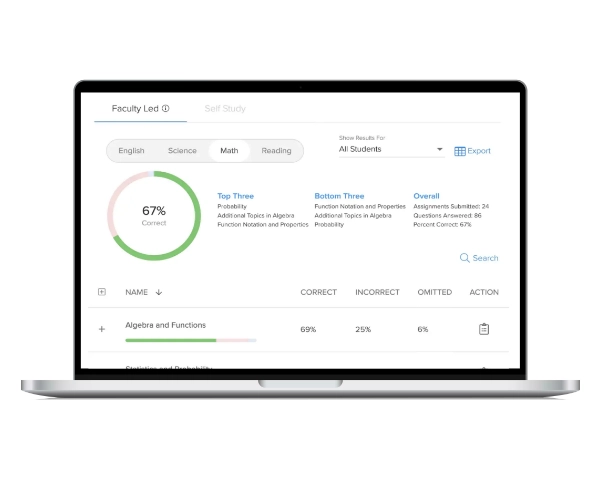Largely considered one of the “seven wonders of the modern world,” the Great Wall of China is one of the most recognizable man-made structures on the planet. The wall is widely believed to stretch 5,500 miles (8,850 km) in length, and was designated a UNESCO World Heritage Site in 1987. This historic marvel unquestionably required years of preparation and work to complete. In fact, the Great Wall was constructed over a period of more than 2,000 years.
AP® Human Geography teachers obviously do not have millennia to prepare their students for their summative exam. In fact, their official test review time is often limited to just a few weeks before the AP HUG test, so the need for careful preparation and planning is integral.
During the final weeks before the exam, AP Human Geography teachers must spiral through every content standard and course topic their students may encounter on test day. This is no easy feat. In fact, as per the College Board’s® 2022 score distribution report for AP exams, just 53.2% of students who took the AP Human Geography test passed with the needed score of 3 or higher.1

Student Score Distributions on AP exams (2022)
HUG teachers must carefully plan for their AP Human Geography final review in order to give their students the best opportunity to perform well on the exam. To help with that process, we have provided five suggestions for a last-minute AP Human Geography review that can be incorporated into any content spiraling plan.

Tip 1: Break Curriculum into Smaller, Doable Parts
As the final weeks of AP Human Geography test preparation approach, the main goal is to review all the course material that might be covered on the exam. However, the limited time available presents a challenge in thoroughly covering all the necessary content to ensure student readiness. That’s where “chunking,” a valuable technique for test preparation, comes into play. Chunking involves breaking down study material into manageable portions.
A study published in the Educational Psychology Review2 highlights the effectiveness of this approach. It allows students to grasp and retain information more effectively, ultimately enhancing their preparedness for assessments. Essentially, dividing information into manageable chunks aids in students’ comprehension and boosts their confidence.
Instead of trying to cover everything in a single review session, teachers can break down an AP Human Geography unit into smaller sections or concepts. By addressing each part individually, students can focus on one topic at a time, leading to better retention and a deeper understanding of the material. This approach helps students navigate through the content more efficiently and increases their confidence in their knowledge.

To get their students ready for the AP Human Geography test, AP HUG teachers can try “interleaving,” wherein they cover multiple interconnected topics at once. Studies show that when teachers interweave seemingly different subjects, students can develop the ability to differentiate between them and effectively identify their shared characteristics.2 By incorporating these test-taking strategies into their lesson plans, teachers can instill a sense of readiness in their students for the AP Human Geography exam. Through the implementation of interleaving, students acquire a more comprehensive understanding of the subject matter, strengthening their performance on the test.
Our choice for an AP Human Geography review guide: Simple Studies
Simple Studies’ AP Human Geography study guide is our pick for the best guide instructors can use when planning for their AP Human Geography test review.
Why We Chose It:
- Comprehensive AP HUG review: Covers various resources and materials for a thorough AP Human Geography exam review.
- Content organization: Provides PowerPoints by unit, study guides, and recommended textbooks for effective topic coverage.
- Exam preparation tools: Offers FRQ workshops, study schedules, review packets, and calculator resources.
- Additional review links: Provides a wide range of online resources, including released FRQs, Quizlet, YouTube videos, and educational websites.
Tip 2: Practice with Released Exam Questions
Giving students the opportunity to practice with previously released AP Human Geography exams is a straightforward strategy that teachers can use to support their students’ exam preparation. This method has a high probability of improving student performance. A study conducted at the University of Nebraska-Lincoln3 found that practicing with authentic test questions, particularly those from released exams, led to an average score increase of 15%. In contrast, studying with different questions resulted in only a 6% improvement in test results.
Our choice for released exam questions: The College Board® secure released exams
The best way to get released AP exams is to get them straight from the College Board. They’re our top choice for getting these exams. Although students can’t access these exams, AP teachers can use them for their AP Human Geography final review. You can find these exams and other new questions easily on AP Classroom.4 If you want more info about the released exams, just check out the AP Classroom User Guides for AP Human Geography instructors.
Why We Chose It:
- These questions are trustworthy and genuine as they come from real exams in previous years.
- They closely adhere to the current format and structure of the AP Human Geography (AP HUG) exam, including the number of questions, question types, and time constraints.
- The previous exam questions cover a wide range of topics and encompass various question types.
- They are designed to encompass different levels of difficulty, ranging from straightforward to challenging.
Tip 3: Multiple-Choice Practice Makes Perfect
Practicing with multiple-choice questions is a vital part of getting ready for the AP Human Geography exam. As teachers review the material, it’s important for AP HUG instructors to encourage students to tackle at least two multiple-choice questions every day. Using exit tickets or bellringers with multiple-choice questions can be a helpful way for students to brush up on key concepts that might come up on the test. By regularly engaging with these practice questions, students can strengthen their understanding and readiness for the exam.
Regularly practicing multiple-choice questions helps students develop important skills such as using annotations, paying attention to context cues, and eliminating obviously wrong answers. These practices significantly enhance students’ test-taking efficiency and accuracy. Moreover, engaging in multiple-choice question practice helps students improve their time management skills and get accustomed to the test’s pace. By consistently honing these abilities, students can approach the AP Human Geography exam with greater confidence and perform at their best.
Our choice for multiple-choice practice: UWorld
If you’re looking for the best resource to practice multiple-choice questions, we highly recommend UWorld’s Learning Tools for AP Courses. It’s a fantastic way to incorporate a last-minute AP Human Geography review with multiple-choice questions.
When students use UWorld’s multiple-choice questions, they receive top-notch explanations that greatly enhance their understanding. The resource leverages adaptive learning technology to tailor each lesson according to the students’ individual comprehension levels. This means that students get targeted practice specific to their needs, which is a huge advantage as they prepare for the AP HUG exam.
One of the great things about UWorld is that students can use it throughout the entire year to revisit learned material, identify their strengths and areas for improvement, and expand their knowledge and skill sets in preparation for the AP HUG exam. It’s a comprehensive tool that offers a quick and effective way to review important ideas and practice multiple-choice questions, especially during the final weeks of AP Human Geography test preparation.
With UWorld’s Learning Tools, students can boost their confidence, refine their test-taking abilities, and maximize their performance on the AP HUG exam. It’s an invaluable resource that can make a real difference in their preparation journey.
Why We Chose It:
- Students receive instant feedback and detailed explanations for their responses to AP Human Geography questions. This feedback aids in their comprehension of the concepts and enhances their problem-solving abilities.
- The resource offers a diverse selection of multiple-choice practice questions, encompassing all the topics assessed in the AP HUG exam. With comprehensive coverage, students can ensure they are well-prepared and possess a strong grasp of all subject areas.
- The practice questions are timed, replicating the time constraints of the AP Human Geography exam. This feature familiarizes students with the allotted time and assists teachers in evaluating their students’ performance within that time frame.
- Teachers have the flexibility to choose specific subjects and question types for their students’ practice sessions. This personalized approach allows teachers to concentrate on the areas where students require the most support, ensuring they receive tailored assistance and are fully prepared for the AP Human Geography exam.

Tip 4: Greater Understanding with Justifications – Studying for FRQs
One of the notable differences between education today and education several decades ago is the recognition of the value of deep understanding. Teachers play a crucial role in facilitating true comprehension by going beyond simply presenting solutions. When getting ready for the AP Human Geography test, it is essential to provide students with ample opportunities to justify their responses. A study published in the Journal of Computer-Assisted Learning5 revealed that students who had to provide justifications for their answers exhibited a stronger grasp of the material compared to those who only provided answers. By incorporating written explanations into the learning process, students can enhance their clarity of understanding and improve long-term retention.
Engaging students in the practice of justifying their answers in writing also prepares them for free-response questions. Additionally, offering online examples of exemplary free-response question (FRQ) responses can greatly contribute to students’ success on the AP HUG exam. By analyzing sample questions, teachers and students can collaboratively generate ideas and develop effective FRQ answers.
Our choice for additional FRQ practice: CrackAP
CrackAP.com is a great place to practice FRQs for the AP Human Geography test because it has a large number of free-response questions, scoring rubrics, examples of good essays, and tips and strategies to help students get better at analyzing primary and secondary sources.
Why We Chose It:
- Comprehensive FRQ coverage: The resource provides a wide range of FRQ practice questions that cover all the topics tested in the AP Human Geography exam, allowing teachers to ensure comprehensive review for their students.
- Last-minute readiness: Teachers planning a last-minute AP Human Geography review can quickly access and utilize the FRQ practice questions from the provided link, saving time and facilitating efficient exam preparation.
- Authentic exam experience: The resource offers FRQs that closely resemble the format and complexity of the actual AP Human Geography exam, enabling students to become familiar with the exam’s requirements and boost their confidence.
- Targeted practice: Teachers can select specific FRQs from the resource to address the areas where their students need the most improvement, providing tailored practice opportunities and enhancing overall performance.
Tip 5: Repetition with Flashcards
Repetition is an effective tool for retaining information when revisiting previous course material and important vocabulary terms. Students can actively learn using flashcards, and repeated practice recalling information enhances their memory over time. According to the Central Penn College Learning Center, flashcards facilitate active recall, engaging students in the learning process by stimulating memory and establishing lasting connections to the material.6
In preparation for the AP Human Geography exam, teachers should cover a diverse range of concepts and essential vocabulary with their students. Engaging in flashcard-based activities helps students maintain focus and motivation during the review process. Whether students use flashcards individually or as part of group activities, regular integration of flashcard-based review exercises in AP HUG classes supports effective retention of vital course material.
Our recommendation for AP Human Geography flashcards: UWorld
We highly recommend the UWorld flashcards feature as an excellent resource for AP Human Geography. It’s our top choice for students looking to enhance their understanding and excel in the subject. With UWorld flashcards, students can create their own customized slide shows and focus on specific topics. It’s an effective and user-friendly tool for studying for the AP Human Geography exam, thanks to its easy-to-use interface and flexible flashcard feature.

Teachers can also assign various review activities that involve the use of paper flashcards. Here are some recommendations on how to incorporate them into your AP Human Geography final review.
Understanding is Key, Not Just Memorization:
Instead of simply memorizing information, try to establish connections with other concepts to enhance your comprehension of the subject.
Create Your Own Flashcards:
Designing your own flashcards compels you to interact with the material and express it in your own words, resulting in better memory retention.
Combine Words and Pictures:
Include both textual and visual elements on your flashcards to establish associations between different representations of the information. This aids in retention and recall.
Make Flashcard Review Fun and Interactive:
To make flashcard review more enjoyable and engaging, incorporate entertaining games and activities. This approach enhances retention and cultivates a positive learning attitude.
Instead of simply memorizing information, try to establish connections with other concepts to enhance your comprehension of the subject.
Designing your own flashcards compels you to interact with the material and express it in your own words, resulting in better memory retention.
Include both textual and visual elements on your flashcards to establish associations between different representations of the information. This aids in retention and recall.
To make flashcard review more enjoyable and engaging, incorporate entertaining games and activities. This approach enhances retention and cultivates a positive learning attitude.
Bonus Tip: Prepare Students with Test Day Reminders
This last piece of advice might sound more like general test-taking guidance than a last-minute tip specifically for AP Human Geography review. However, it’s crucial to discuss what students should do and bring on the day of the exam. Every year, there are students who forget to bring a pencil, turn off their phones, or even show up late for their Advanced Placement exams. But here’s an interesting finding from a study conducted by The College Board7: students who arrived on time and had all the necessary supplies for their AP exam scored an average of 20 points higher compared to those who were late or forgot their materials. So, it’s important to go through a preparation checklist for the AP Human Geography exam with your students and ensure they have all the required supplies on test day.
Checklist of Reminders for AP Human Geography Students
The Day Before the AP HUG Exam:
Ensure you get a full eight hours of uninterrupted sleep
Gather all your materials and prepare for the test
Avoid excessive studying
Stay hydrated and have a well-balanced meal
Take some time to relax and engage in stress-relieving activities
Review test-taking strategies
Double-check the exam’s location and start time
Set multiple alarms to ensure you wake up on time
Remember to pack a valid government-issued photo ID and all necessary items
Plan your transportation to the exam location
The Day of the AP HUG Exam:
Bring multiple sharpened No. 2 pencils with erasers
Bring a pen with black or dark blue ink
Bring a valid government-issued photo ID
Bring your AP student packet, which includes the AP number label and a demographics sheet
Bring your exam ticket or registration confirmation
Have a watch with you to track time
Bring water and a snack. Remember, they must remain on the ground throughout the entire test and can only be consumed during breaks.
Key Takeaways
For teachers aiming to provide their students with top-notch AP Human Geography final review, it’s crucial not to underestimate the significance of the last few weeks leading up to the exam. By implementing the five suggestions outlined in this article, AP HUG teachers can effectively enhance their students’ confidence and level of preparedness for the exams.
Learn more about how we strive to support AP teachers who want to make a difference in the lives of their students with our Learning Tools for AP Courses.

References
- Student Score Distributions* AP exams – May 2022. (n.d.). Retrieved March 22, 2023, from https://apcentral.collegeboard.org/media/pdf/ap-score-distributions-by-subject-2022.pdf
- Rohrer, D. (2012, July 28). Interleaving helps students distinguish among similar concepts – educational psychology review. SpringerLink. Retrieved March 21, 2023, from https://link.springer.com/article/10.1007/s10648-012-9201-3
- The effects of age and professional expertise on … – Wiley Online Library. (n.d.). Retrieved March 22, 2023, from https://onlinelibrary.wiley.com/doi/abs/10.1002/acp.1467
- Formative assessment. AP For All. (n.d.). Retrieved March 29, 2023, from https://apforallnyc.com/formative-assessment/
- Let me explain! the effects of writing and … – Wiley Online Library. (n.d.). Retrieved March 22, 2023, from https://onlinelibrary.wiley.com/doi/10.1111/jcal.12608
- Libguides: Learning Center – Study Skills: Flashcards. Flashcards – Learning Center – Study Skills – LibGuides at Central Penn College. (n.d.). Retrieved March 22, 2023, from https://guides.centralpenn.edu/c.php?g=695569&p=4999857
- Source: College Board. (2021). AP Exam Score Distributions. Retrieved from https://reports.collegeboard.org/media/pdf/2021-ap-student-score-distributions_1.pdf be




